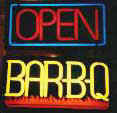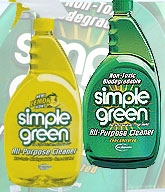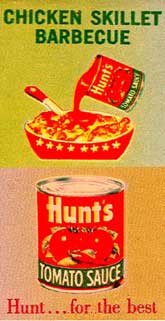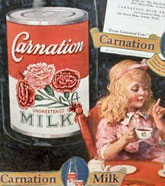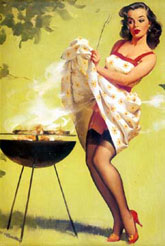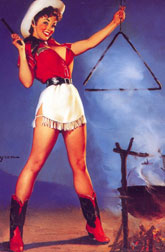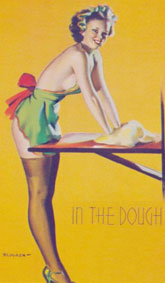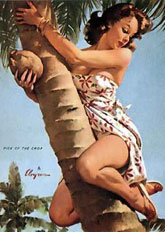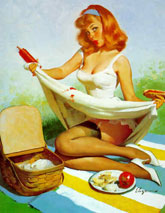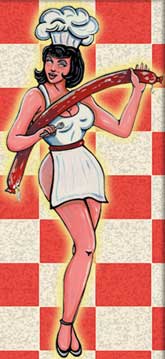Contact BBQbyDan
www.BBQDan.com
Search
KCBS BBQ Cook-Off Info
Recipes,
Smoking Meats
Recipes, Grilling
|
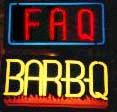 |
FAQ OF THE INTERNET BBQ LIST Version 2.0 Section 19 Barbecue Contests |
--------------------
[Where can I find out where barbecue contests are scheduled to be held?]
Glenn Manning--
The KCBS Web site has a listing of sanctioned contests:![]() Click here
Click here
Check out the MIM Event Database Web site: ![]() Click here
Click here
The MIM home page Web site: ![]() Click here
Click here
Check out the MIM barbecue contest rules: ![]() Click here
Click here
[Can someone tell me about entering barbecue ribs in a KCBS sanctioned barbecue contest?]
Frank Boyer--
Most ribs that are turned in have a glaze on them. Honey is usually in the glaze because it gives a shinier look. KCBS, and other KCBS affiliates use an absolute standard meaning that more than one turn in could have all 9's(highest score). MIM uses a comparative score meaning that only the best turn-in on your table gets a 10 ( highest score). I have never judged in any Texas contests, I understand that some TX groups do a multiple round judging with each judge tasting every sample. A table is usually six judges that usually judge six boxes from six different cookers. The items are judged for appearance, taste, and tenderness. Taste counts for 50% and the others for 25% each.
On appearance: a reddish brown color; about 1/4-1/2" pull back on the bones; pink in the middle and possibly a smoke ring; membrane removed; full meat coverage of the bones; neat slicing; placement of the ribs in the container; a clean container; use of green leaf lettuce and parsley only for KCBS, meat only for MIM; you can use spare ribs, St. Louis ribs or loin back ribs. It is important to make these ribs look attractive to eat. Ask yourself, "Would I like to have these ribs served to me at a restaurant?"
On tenderness: I do a tug test. Use your teeth to tug on the meat, it should give a slight resistance and pull cleanly from the bone. The meat should be moist and tender, never tough, mushy, dry, or falling off of the bone. The majority of the fat should be rendered off during the cooking.
On taste: the most important part of the judging is the meat, does it taste good. KCBS allows an item to be sauced/glazed but no puddling or containers of sauce. MIM allows saucing/glazing and containers of sauce and/or rub to taste with the meat (taste the meat, then the sauces and then the meat with the sauce that you like the best, often a mild and a hot sauce is included). My overall impression in taste is the meat, rub, wood, and glaze/sauce as a combination.
--------------------[In a KCBS sanctioned barbecue competition, how do you prepare the entry for the appearance portion of the judging in any category? What are the judges looking for in the various meats and is it important how you lay the meat out on the greens?]
Frank Boyer--
The turn-in boxes are provided by the promoter. The cooker is responsible for what goes in the box. Sometimes the promoter may supply green leaf lettuce and/or parsley as a favor to the cookers, but 95% of the time the cookers buy the greens.
Most cookers use the greens to frame the outside of the turn-in to get a contrast in colors. Since there a lot of teams with 175 and above scores(180 is the highest possible) every point is important.
The garnish is used in KCBS events. MIM and most of the six Texas sanctioning bodies do not use any garnish in the turn-in boxes. Texas does mostly meat only without any obvious sauce. KCBS allows some sauce, but no sauce in containers and no puddling of sauce. MIM allows up to two containers of sauce and/or rub to be turned in with the meat and the judge tastes the meat as turned in, then with each sauce (if any) and then judges it with the combination that the judge likes the best.
==============KCBS Competition--Presentation
Dave Westebbe aka EskWIRED--
Presentation is both simple and complex--kinda like playing most board games--the rules are simple, while the execution is complex. Scoring is on a 1 to 9 point basis.
Aside from the meat, you are allowed to put only green leaf lettuce and curly parsley in the container as a garnish. No flat (Italian) parsley; no red leaf lettuce. No toothpicks, no foil, etc.
The meat may be sauced or not--your choice. However, the sauce may not be "on the side". It must be on the meat. Puddled sauce is considered to be on the side.
Any violation of the above will result in your getting a 1 on presentation.
You must include at least six identifiable portions of meat in the container. If you have less, the judges who get none will be obligated to score you a 1 on flavor and texture.
That's it for the simple part. Nothing to it. Now for the fun part.
You want your barbecue to look delicious. The judges are not supposed to judge taste based on appearance, but how could they not? If they get a container with food that looks delicious, then they will be pre-disposed to judge it higher than if they get a container which looks mediocre. You want them to be thinking, "Wow--I can't wait to taste that one!" First impressions are very hard to change.
Its good to bring lots of fresh, crisp, curly-edged lettuce, and to pick out the best looking leaves for each dish. I like to arrange it so that the curly edges surround the meat, stem-side towards the center, covered by the meat. There should be no blemishes on the lettuce, no brown spots, no tears, no light-colored, limp, last-gasp at the supermarket stuff. I go to a wholesale fruit and vegetable dealer for mine--I make a special trip. Try to pick leaves which are consistent in color--they get lighter towards the center of the bunch. I save the small, delicate inner leaves for stuff like chicken, and use the big, heavy outer leaves for stuff like brisket. I have not yet tried to alternate light and dark leaves, but am thinking about it.
I try to be sure that no sauce has splashed onto either the lettuce or the container, and keep a towel handy to wipe off any sauce or fingerprints. A stray fingerprint on the outside can result in your disqualification, if the judges think that you have "marked" your container.
The parsley. Try not to overdo it. Again, use only the best, crispest, curliest, greenest parsley available. Wash it! You don't want any sand in your container! My philosophy on parsley is that it can be used to fill voids in the box, and can be used to draw the judge's eye towards the best looking parts of your presentation. It can also be overdone, and can distract the eye. We use very little, more as an accent than as an element unto itself.
The meat. Like I said, you need at least six identifiable portions. Its sometimes good to include extra if your meat came out particularly good. Its sometimes good to include more than one type of presentation in the box--for example, some burnt ends can be included with your slices of brisket. Sometimes its good to include a big hunk of meat with your small portions, if you have something nice to look at. Did your butt come out a beautiful reddish-brown? Then don't pull it all. Put some Mr. Brown in there beside the pulled pork. Did your chicken turn a nice color with nice grill marks? Throw in a whole breast. You get the idea.
Slice your meat in a nice, even, consistent manner. Don't give one judge a little piece if everyone else got a big one. How will he feel good about your meat if he feels cheated? Arrange the meat evenly, with the slices nicely arranged. Push and pull them into position. Put the best-looking ones on top. Cover up the ragged uneven parts with parsley. Think about whether you want them at an angle, sideways, straight across, or what. Maybe a sunflower design? Where will the sauce go? All over? Drizzled like chocolate sauce? Brushed on thin? Poured on thick?
Its good to be creative. You want to catch the judges eye. Look for balance and color. Do you have any artist friends? They can help. Try to make your cheesy little Styrofoam container look suitable for the cover photo on Bon Appetit magazine! Think about what the plates look like at fancy-shmancy nouvelle cuisine restaurants, and try to create something spectacular. A good eye is essential.
And stay flexible. Quick thinking is also essential. You must adapt your final presentation to the lettuce and the meat during your 10 minute window. Its best to have 10 ideas in mind and to quickly pick one than to be set on one idea which may not work given your cooking results. For example, if your pork is black instead of dark red, don't be wed to the idea of including Mr. Brown. Instead, cut off the char, pull it, and do something nice with the sauce instead. We once cooked boneless rolled chicken breasts which all came out raw in the middle. Disaster!! We had planned to serve the one best breast sliced on the diagonal, laid out nicely in the tray. We couldn't do it, because all of them were raw in the middle. Despair, gloom, resignation. Not even one breast to enter into the competition! No time to cook them more! With no points for chicken, there was no hope for any kind of decent overall finish. And then we got an idea. The End Cuts were cooked. They were browned. We had 4 breasts, each of which had two ends. Eureka! We presented the end cuts only, won first place in chicken, and first place overall. Flexibility in presentation made the difference between a first and a last place finish.
Finally, presentation can get you 54 points even if your meat is inedible. Lost points here can make the difference (easily) between a first and a fourth place finish. Its hard to cook prize-winning barbecue, and a few 8s and 7s on taste and texture are nothing to be ashamed of. However, there is no excuse in my mind for anything other than straight 9's on presentation. Why lose points here?
==============Mike Roberts--
I'll add two thoughts to what Dave wrote:
Be careful about how "creative" you get. I worked for several months following the 1994 Massachusetts State Championships in hopes of improving my presentation scores. I was told by the KCBS representative that that was the area I was falling down in. Back then, they did not give out detailed scores so I had to convince the KCBS to allow me to see the details of my entries. I got them.
Well, I took it on in a straight forward way--I got several of the 9 x 9" Styrofoam containers to practice with. I used nothing that was not part of a head of green leaf lettuce or curly parsley. I worked and worked and worked. I made many trips to libraries to search out garnishing books. I talked to chefs, caterers, barbecue competitors. I did database searches in all major bookstores in this area, and on and on. I was determined to leave no stone unturned. Damn it, presentation was not going to get the better of me. My father was a successful artist and I feel that I have some of his eye for things like that.
Well, I finally connected with my 9 x 9 Styrofoam container, meat, lettuce, and parsley. We began to make music. I was excited! I carefully took closeup photos of each presentation style and made an album so I could just refer to set of styles for a particular meat. I went to the 1995 Massachusetts State Championships and man-o-man was I ready. Then it happened.
The evening before judging day, the Head KCBS Rep. and his wife stopped by my canopy for a chat. I took the opportunity to talk to them about what I had been doing to improve in presentation. I could not believe my ears as they told me I'd be disqualified if I used my styles. According to both of them my creations would be considered: Marking!
Marking! As politely as I could, I asked what was the point of scoring presentation if you could not make 'your' entry 'stand out' from the rest. Wasn't that what 'presentation' was all about? "Yes, but you can't do it in such a way that can be considered marking. "Wow, where do you go from here? Make it stand out, but don't make it stand out!"
I did okay. I placed 2nd pork, and I moved up in overall standing. However I also pulled back on my presentation. I could not risk being disqualified because I was misunderstood as trying to 'mark' my entry. It is one thing to risk a local cookoff or two, but not a State Championship.
That damn Presentation category is a real pain in the arse. Other judging regions in the country do not use it, and I wish that KCBS would follow their lead.
-------------------[Can you tell me about barbecue competitions that are sanctioned by MIM?]
This section written by Rick Day--
The purpose of this section of the BBQ List FAQ is to provide information on what it takes to compete in a Memphis in May style Contest. The first five parts cover On-Site Judging. Part six covers Blind Judging.
Part I -- Preparation Of Team Area
-------------------[How do I prepare my team area for competition?]
One of the most important things you can do is clean the grill. Before the contest, clean as well as possible the outside and the most visible parts of the inside. Use a car wash or steam sprayer to remove as much non-metal as possible. Clean the cooking surfaces well. The old style of thinking 'Never clean that smoker's insides' won't fly in competition. If you don't want to clean the inside, consider using a second smoker, acting as a 'presentation' smoker. Before your judges arrive, it is a good idea to wipe the exterior of the smoker with a hot wet rag, followed by a vegetable oil coating. This makes the paint shiny and makes for an impressive presentation. This lets the judge know you are concerned with health regulations and cleanliness in entry preparation. If you use utensils or smoker tools, make sure they are clean and well presented; otherwise, hide them. The grill should speak for the team and the cook, and as the judge approaches your smoker, these things will have an impact on his or her overall impression, especially if you neglect these details!
If your smoker is mounted on a trailer, clean everything, even the tires! Make sure your rig was designed with presentation in mind. Also know before the judge gets there where are you going to stand relative to the judge, what is to be the teammate placement, etc. Assure the footing in your area is good, especially on damp days.
The fuel you use should be highlighted. If you use charcoal, logs and chips, have a bowl of chips handy to use as a prop, and have several clean bags of the charcoal displayed in a pleasing manner. Have a log handy for inspection. What you use as fuel is not as important as conveying to the judge why it is used.
-------------------[How do I prepare my presenting area?]
You must have a tent, awning, or other weather-proof covering, because no judge wants to be sampling barbecue in the wind or rain. When deciding on the covering, take into consideration how much space you will need to cover, and how that size interrelates to the standard booth sizes available. Most contests are restrictive on taking up room, so in Memphis in May Contests, a 10 x 10 is the minimum size for covering the presentation table. Some teams need 20 x 20 or larger. Keep in mind, depending on tent size, a tent can take from one to six people to erect! There are "easy up" tents on the market, and depending on your team's needs, and much thought should be given to this major team asset purchase. Also remember the stakes are sometimes placed outside the parameter of the actual tent, so this should be taken into consideration when determining layout in a given booth space. The material should conform to event fire standards. Check with your organizer or rule book on these specifications. You should also consider curtains, which is tent fabric that makes temporary walls in different configurations.
You may consider using flooring, made of plywood, pallets and outdoor carpet, in case the weather turns wet. Make sure you have provided buckets of sand for smokers to place their butts; its no fun throwing a party Friday night and then have to pick up hundreds of cigarette butts under your tent the next day!
Erect a temporary fence at your front border. Try finding out if your neighbor has side fencing. This way you do not have to lug extra fencing on a side that is fenced off anyway. The fencing adds to the aesthetics, as well as keeps unwanted visitors from crashing your judges party! It obviously helps with crowd control at all other times.
Hot weather usually brings out small fans for the judges relief. Conversely, propane heaters and cozy curtains provide relief in cool weather. The rule of thumb is to make the judge as comfortable as possible during their brief stays at your booth.
Although the judges are instructed to ignore any expense you went through, they do notice the efforts! Your site should be devoid of any trash on the ground. If some item is needed for judging, make it as perfect as the situation allows. If it is not necessary, put it away, out of sight!
The rule of thumb on table setting is to present and treat the judge as if he were a Sunday Dinner informal guest. The place ware should all match. Use goblets or matching tumblers for the judge's drink. Flatware is provided as a accouterment to the table only; judges rarely use it. Plate net covers are a nice touch to the table. Make sure you have a sample of your sauce and rub for the judges to sample, as well as other prop's, to utilize during your presentation. Most contests have various regulations regarding the teams feeding judges, ambassadors or assistants. If you do serve them, make sure there is a place for the assistant to sit, and a place setting is provided. Just make sure your focus is on the judge!
Some teams will garnish the plate with interesting visual designs of fruit, lettuce, etc. Think about things such as sun position, windage, the line of sight to neighboring teams, rain runoff flow, ergonomics of moving and trophy table placement when deciding where the judge will sit. Set up your site so the judge has almost 100% of possible distractions eliminated, but has 100% focus on the presentation.
-------------------[How do I prepare my team for competition?]
Most of this is obvious advice. The team should look like a team; all clothing should have some continuity. You do not have to purchase imprinted shirts, caps, aprons, badges, etc. While they look good, the judge is looking more at conformity. If one wears black shorts, then all members of the presentation team should wear them.
It is not difficult for a team to wear matching apparel that goes with their Team Name, sponsorship affiliation, etc. Just make sure there is continuity. Make sure the team clothing is all clean and spotless for the judging part of the competition. Indeed, extra caps and shirts should be brought in case the inevitable accident occurs.
Organize and instruct your team members exactly what they are to do. This further conveys the concept of team continuity, and prevents fumbling during presentation. Introduce the presentation team to the judge, but do it quickly, because you only have 15 minutes to do your thing! If a team member has a special responsibility that impacted the product, it is proper to convey that to the judge. Rehearse with the team, grabbing a bystander to act as 'judge', so you can work out any potential problems in moving bodies around. Some teams limit their presentation teams to 2 or 4, even if they have 10-20 members! Have the extra team members align outside the fence, looking as clean and professional as the ones inside.
It is imperative you have at least one team member act as 'gate guard'. Many times a 'civilian' will wander in the booth area during judging, sometimes in a non-sober state! The last thing you want is a confrontation with a hungry drunk over what he can and can't have during judging. Give each team member a specific responsibility for before, during, and after each judge's arrival. The main presenter should stay out of the way and let everyone do their jobs; taking dirty plates away, bringing a fresh plate, grill and table garnishment, carving samples. The blind judging preparations are areas that the Head Cook can delegate to the team. Encourage the team to participate in the Ancillary events that contests have, such as showmanship, sauce, anything butt, etc. It makes them feel more of a contributor.
PART II -- Preparation Of Entry
-------------------[What do I need to consider when preparing my whole hog entry?]
If you are competing in whole hogs, the minimum entry is 85 lb. dressed weight. The hog is cooked and presented with all parts intact. Make sure all fresh meat entries are kept cold, 45F or cooler, for meat inspection. Internal temperatures above this mark will result in the hog being disqualified. Trim the hog according to personal taste, but do it carefully. The appearance of the finished product is very dependent on the trimming of the hog prior to cooking. The more skin that is removed, the more 'bark' can form, allowing tastier sampling for the judges. Smoke may color the skin, but it cannot permeate it, so the more skin you can cut away the better.
During preliminary judging, work off the away side of the hog when getting judging samples. This makes the hog's appearance better for the later judges and perhaps the finals judges. Give a sample of the following parts of the hog's: shoulder, loin, rib, ham, bacon, (but don't take too long or you may run out of time). This will demonstrate your hog is completely cooked, which is one of the criteria judges consider in this category. Garnish the grate around the hog with various greens and colorful highlights, such as peppers, pineapples, gourds and other food related garnishes.
Remember the first thing a judge is impressed with is 'Appearance'. Do not present a black hog and expect good scores in appearance. Spray the hog with vegetable oil spray, and as you cook, wipe off the skin with a paper towel and apply more spray. This will give the skin a golden-brown appearance. Present the hog flat on its back, or up in a running position, as your skill dictates.
The main thing is convincing the judge that you did things for a particular reason. How you present the hog is up to you. Again, convince the judge your way is the best way.
-------------------[How do I present my Pork Shoulder Entry?]
Pork shoulder is defined as the entire shoulder to be one unit, containing a portion of the shank, arm, and blade bones. Pork ham is considered a shoulder entry, but it never does well against shoulders, so the shoulder is definitely recommended.
Most teams utilize five shoulders for each competition, each 14 to 15 pounds. Trim the shoulders into an appealing shape for the judges. Try to present a whole shoulder to each judge, rather than sharing shoulders. If you share a shoulder with two judges, you better come up with a good explanation as to why that judge didn't get 'their own shoulder'. Demonstrate tenderness and doneness by pulling the blade out of the shoulder and allowing the judge to inspect it for dryness or any clinging meat. Make sure and save a whole shoulder for the Finals!
-------------------[How do I present my Rib entry?]
The pork rib entry is defined as that portion containing the ribs and further classifies the spare and loin portions. Country Style ribs are an invalid entry at MIM. The judges at MIM prefer a loin back rib, which is a 13 bone slab which weighs 2 lbs. or less. You should have at least 13 slabs of ribs for MIM competition. Decorate the grill and place your entry in the center of the decorated area. Some teams use halogen or spot lights on or near the cooker for this purpose. Demonstrate the tenderness by pulling the slabs into sections of 3 or 4 bones. While at the table, cut a slab into single bone 'Hollywood' cuts, as well as some two bone sections for the judge to pull apart and sample. Some teams give samples of the ends to the judges, to help show an overall doneness to the judge for that sample. Remove the back membranes before cooking competition ribs. See the section on sauces.
-------------------[How do I prepare and cook these entries?]
You entry must remain as received from the packing house or meat market until it is officially inspected at the contest by the designated official. Once this is accomplished, you may prepare your entry for cooking as you see fit. Before this inspection, any marinating, injecting, curing or otherwise pre-treating the meat in any way can result in disqualification of that meat.
Trim your entry liberally; get all the exterior fat off. Again, appearance is a top area of judging. Use your favorite hardwood, charcoal or combination. It really does not matter what fuel you use; what is important is the ability to convince the judge why you made that choice.
-------------------[When should I start cooking?]
The rules allow you to start immediately after meat inspection, but the rule of thumb is to count back from the time your entry must be ready (15 minutes before the hour for the blind testing and the top of hours and every 20 minutes for on-site). If your shoulder takes 24 hours, put them on at 11 a.m., if judging is noon the next day. Make sure and compensate for the whether and how it impacts your cooking process.
Generally, whole hogs take 16-24 hours to cook, shoulders 14-20 hours and ribs 3-6 hours. Don't forget to make sure you have an entry ready for Finals Judging! This timing is why it is so important to monitor your grill temperature.
Plan on serving your first judge right at the top of the hour, the second approximately 20 minutes later and the last, 20 minutes after that. Judging takes time. Preliminary judging takes about one hour for each category. Hog is usually first, followed by shoulder and then ribs. Check with your organizer for entry times. You should also take into consideration if you are entering one, two, or all three events. This takes quite a bit of coordination, so be prepared for this part!
Ribs are almost always judged last. That way when the Finals judges go around, they have tinier portions to sample on the backside of their trek. One rib tells the story, as opposed to the 3-4 parts that must be sampled on hog.
-------------------[When should I plan on Finals happening?]
Finals Judging usually begins about 3 to 3 1/2 hours after the Preliminaries. The first category judged will be the first Preliminary category of the day judged. Rib cooks should prepare 4-5 slabs independent of the Preliminary Samples, since hogs and shoulder hold better than ribs.
-------------------[What is the deal on using foil?]
While there is nothing wrong or illegal in utilizing aluminum foil for your cooking, judges frown on seeing it on your smoker, unless it is part of the garnish. The appearance of foil on or around an entry is a turn-off, therefore foil should be avoided.
PART IV- Dealing With Judges
-------------------[When is MIM judging?]
Check with your organizer. Usually the first category starts on Saturday at 11 a.m., the next category starting at 12:00 or 12:10 and the last category starting at 1:00 or 1:20. The conventional way used to be at the top of each hour, but this does not give multiple entry teams much time to prepare and turn in their blind samples while the last judge is still in the booth.
-------------------[How do I treat the judge?]
A representative of your team should greet your judge at the gate. Make sure they give you, or your gate keeper, a critique stub, that has your team name and the order of judging. Both you and the judge share responsibility for making sure that judge is at the right place at the right time. Do not have a beer in your hand for the judge! Offer your judge bottled water, and have some cold ice in a glass standing by. It is not necessary to prepare for any other drink the judge may want. Think about it; you want that judge to have a clean and unaffected pallet when sampling your product.
Make the judge feel welcome and comfortable. Do not act nervous; this shows as amateurish and may affect the overall score. Do relax, smile and laugh; infecting the judge with your attitude makes your job a lot easier! Make sure you make eye contact when explaining your method of contest preparation. Try to keep yourself at mutual eye level with the judge at all times.
-------------------[How do I present to the judge?]
The first thing a judge usually makes a mark on is, 'Area and personal appearance', scored from 1-10. As to what to say to the judge, think about what you are going to tell them in advance. Practice your timing, so many minutes at the smoker, so many at the table, etc. The last thing you want to do is run out of time before the judge even gets to sample the product! Keep a timer handy, or a clock nearby, so you, or a designated team member can keep track of the judge's progress.
What you tell the judge is simple. Tell him or her how you did something. Then tell them 'why' you did it. Judges like rational explanations as to why did you choose this wood, or that rub, or this charcoal. There are no 'right' answers, just answers. If you try BS'sing the judge with stories of moon rocks and ancient recipes, it may have a negative impact on the more serious judges, who don't take kindly to people yanking their strings during what is considered a serious time. If you thoroughly cover the aspects of your process, tell about your team, and just have some fun with the judge, you will get great marks on presentation every time. Try to cover any and all questions in your presentation. Ask the judge toward the end of the presentation if they have any questions--the fewer they have, the better job you did! This section of judging is called 'Presentation', with scores being from 1-10. Try to remember what the first judges asked you and include that information in your next presentation. Do not bitch about your entry, no matter how bad it is! Convince the judge that your entry is black on purpose, and come up with a logical reason why it is that way. Remember in Preliminary judging you are competing against two other teams for that judge's decision as to who of the three has the best of the day. What is mediocre to you may just get you to the big dance!
Prepare your grill for the judge's critical eye. Clean cooking surfaces and grill exteriors get you further than heads of lettuce or cabbage! But a little dressing won't hurt either, so garnish the cooking surface as you see fit. The judge should immediately focus on your entry once you open the door. This is the point when most judges will make their 'Appearance Of Entry' judging scored from 1-10, so this is an important part of the judge's presentation.
-------------------[How do I tell the on-site judge about my barbecue?]
Again, make them immediately feel comfortable and welcome. Convey a sense of excitement and organization. Offer the judge some water to drink as you take him to the grill, and let that judge know that something to drink will also be at the table. Lead the judge to the cooker, after introducing yourself and the team. This is your home ground and judges are very curious as to how you approach your craft. Point out with great pride your smoker and how it looks. Allow the judge to sample at the grill, if he desires, and point out aspects of the smoker that make it unusual or unique in its way of cooking. Give the judge just enough information at this point on your basic style, but save the details of the process for the table.
If you use food handling gloves, shake the judges hand upon greeting with an non-gloved hand; then place the gloves on before handling meat. Any utensil touching the meat must be spotless. Take them back to the table and let them sample the product. This is the time when you want to go through the cooking process from start to finish. This allows the judge to eat and listen as you go through the process. It also gives you the flexibility of controlling the balance of timing left to you for this judge. Serve the absolute best portion of your entry. This is the part where the judge makes their decisions on 'Flavor Of Entry' and 'Tenderness Of Entry', scored on a scale of 1-10. Never have any fat hanging off any samples brought to the judge for consumption. Get the judge involved as much as they are comfortable with. Allow them to pick their rib entry, or pick some bacon off the hog, etc. Never make the judge feel uncomfortable, but also keep in mind its more fun to participate than just be talked to.
-------------------[How is the sauce judged?]
Offer at least two sauces for the judges to sample. This is more critical in hog judging than ribs, as most whole hog will not have a lot of barbecue flavor; the balance of that flavor comes from the sauce. Important--do not kill the judge's taste buds with hot sauces. Judges frown on their pallet's being devastated before they can sample your barbecue. It is an obvious dirty trick and most judges will bounce you out of the Finals with low scores for this tactic. You may choose to serve a sauce or not. Just be prepared to explain 'why' you chose this sauce, or didn't, if that be the case.
Have samples of the sauce at the presentation table, if necessary. The judge has the option of judging the meat with or without the sauce, whichever he feels will be to the betterment of the team.
-------------------[What condition should the meat be for judging.]
With the pork shoulder, present the whole shoulder, pristine and not broken up. If the shoulder is falling apart tender on the smoker, your 'Appearance' scores will be marked down. Pull chunks of meat for the judge to sample. Make sure the meat is not in too big of a chunk, making that judge's job awkward. With the whole hog, present the different pieces and portions for the judge, identifying each area of the hog on the judges plate. It is recommended you get samples from the various parts of the hog and then place them on the plate. Your ribs and shoulder can be actually brought to the table, but indeed it is an impressive but folly presentation to bring the hog to the table! Ribs can be presented as the team and quality sample availability dictate, but if you only give the judge two bones of ribs to sample, this tells the judge you had some kind of problem. He may mark your score down for this, or any of up to 20 different reasons. It is the judge's challenge to choose which team of the three he judged, had the 'best of the day' in the 'Overall Impression', which is scored from .01 to 10.0. This decimal scoring in 'Overall Impression' allows the judge some flexibility in differentiating one high-quality entry from another.
-------------------[What do we do when the first judge leaves?]
If you have at least four people on the team, give the judge a 'big hand' as he leaves, this being the last impression you can give a judge. If necessary, the presenter should quickly go over any presentation snafus with a team member in a diplomatic way, as this is a high-tension time for all. A team member should have been given the responsibility of clearing the dirty plates, replacing them with fresh ones, and generally get the table ready for the next judge. You get five minutes between judges number one and two, as well as two and three to prepare. Sometimes the judge can be early by 2-5 minutes, so if possible, have the greeter approach the judge. If the greeter has no other responsibility, have them entertain the next judge, perhaps offering refuge under a huge golf umbrella, as weather dictates. This also gives the extra benefit of distracting that judge from observing your cleanup and setup, until it's 'officially' time to start judging. This free time for the judge in front of your booth can not help but start him or her subconsciously forming opinions as to what to expect. This detail is similar to dozens of situations the championship teams sweat over.
PART V- Finals Presentation
-------------------[What is the Final Round in MIM competitions?]
The preliminary judging is broken down into two parts. Fifty percent of your score is from your blind entry, and the remainder is from your on-site judging. Once the scores are tabulated (blind judging has the same categories as above, but not judging your area and presentation). The lowest score in each category is dropped and 'Flavor of Entry' is weighted an additional 50%. There is a potential preliminary perfect score of 1020. The top three highest-scoring teams in each category (nine teams or less, if some teams make finals in more than one entry) go into 'Final Round'.
-------------------[How will we know if we make Finals?]
You will be notified, usually within one hour after entry judging if you made the finals or not. Protocol is to notify the teams that they made finals, then notify all other teams that they didn't. If Hog judging was at 11 a.m., sometime during shoulder judging at the noon hour is when you should expect to find out whether you made hog finals or not.
-------------------[What happens during Finals Judging?]
Every team that had an entry that made the finals will be visited one time for that entry, by four on-site judges. There is no blind judging, as of 1998, in Finals Judging. The judges stay for 10-15 minutes, just like preliminary on-site judging.
-------------------[What if we do not make finals?]
Be thoughtful of neighbors that are in Finals competition. Avoid turning on your music if a team is within 4 booths of you and are competing in the Finals. Do not tear down your site until your next door neighbor has finished with Finals presentation. To not attempt to leave the site with all your items until trophies are awarded, as a courtesy to everyone. Generally, the Golden Rule applies to the situation.
-------------------[When can we plan on the finals judges arriving?]
A rough rule of thumb is three to three and a half hours after preliminary judging, is when you can plan on finals occurring in that category.
-------------------[What if we didn't bring enough items for Finals?]
This area is exactly why you should make friends with your booth neighbors! Send you teammates around to other teams that did not make the finals and ask to borrow items needed. You will be surprised the number of lifetime friendships on the circuit have been started by helping a stranger and neighbor in this situation. Seek out old pros for advice, that is what they are there for!
-------------------[How do you present to the Finals judge?]
The most important thing is to be prepared to make the finals. Make sure you have plenty of garnish for a freshening of the smoker decorations, enough place settings for four, and your table and site can accommodate the logistics of moving four bodies around your presentation. The most basic way to approach Finals is take your preliminary judging routine and multiply it by four. If you have enough team members for presentation during preliminary rounds, have three team members 'trail' the preliminary judge, in effect taking up the same area as four judges. This can really be a great help in finding snafus in your layout and presentation. Make sure your uniforms, utensils and everything is absolutely perfect. Finals judging allows decimal scoring in all categories, and their job is to be ultra picky on the details.
-------------------[If we make finals in more than one category, should we change our presentation?]
Besides the obvious changes in dialog shifting to talking about the specific entry, never ever deviate from your presentation. Do not skip talking about your smoker, or the cute story you already told, even if you make finals in all three. Do not say, "Let's skip the introductions" and statements like that. It will cost you in presentation scoring! The more exact your presentation is, the better the judges like it, especially when trying to decide a Grand Champion.
-------------------[How is the Grand Champion determined in a MIM event?]
Once the last team (almost always ribs) is sampled, the Finals Judges mark their scorecard, and turn them into the MIM Judges Official, for entry into the computer. The Top Scores in each category are awarded First place in their category. The descending scores are awarded Second and Third place, respectively. The overall entry with the top score is declared the Grand Champion.
-------------------[What do we expect to win if we are awarded the Grand Championship?]
Each contest usually posts the prize money on their mail outs or entry blanks for the contest. The grand Champion always receives an additional trophy or plaque, more cash over the first place money they have obviously won, and a Paid Entry into the following year's Memphis In May International Barbecue Cooking Contest, MIM's equivalent of a World Championship. It actually pays for a 20' x 20' space, and the team has the option of upgrading to a lager size, by paying extra.
-------------------[What is a Pass Down?]
During the last few years there have been teams that have dominated the circuit, winning Grand Championships early in the year, and securing their 'Paid Entry', per above. If a team is declared the Grand Champion, and already have been awarded a paid entry from a previous win, the 'Paid Entry' is 'passed down' to the next team that does not have a 'Paid Entry'. In November and December, when teams are going head to head for team of the year, it is not unusual for the fifth place shoulder team to get the pass down!
PART VI- Blind Judging
-------------------[What is Blind Judging?]
Blind judging is the preliminary category whereby teams turn in samples of their entries for judging at a table of four judges. Usually there are between four or five entries judged at each blind table.
-------------------[When is the entry due?]
The organizer will inform teams at Fridays Cook's meeting what time your blind entries are due. At almost all MIM contests the entries are allowed to be tuned in from fifteen minutes until one minute before the on-site judging is to begin in that category. If you are not in line at the 'official' top of the hour, your blind entry will not be judged.
-------------------[Why is it called 'Blind'?]
The meat is turned in utilizing clamshell Styrofoam containers, with no visible markings on the outside allowed. The entry contains only meat that is to be judged. No garnishment or pooling of sauce is allowed. Separate cups are provided for the sauces. Saturday morning the cups and clamshells are given out, each has attached a label that with the following information: Team Name, entry category, turn-in times, and booth or team number. Do not remove or alter these labels.
-------------------[What happens during 'Blind' Judging?]
The labels are removed by the officials, once they view the entry, also making sure there is no garnish in the box. The box is assigned a table number and entry number, which is noted on the removed label, and placed on an official form. An example for sample 3 on table A would be marked A-3. The official in charge of blind judging has the list that matches team number with box code. About 10 minutes after the hour, the judges are allowed to open the boxes. They usually make their 'Appearance' judgments at this time. The judges then sample each box and mark scores for 'Tenderness and Flavor of Entry'. As in on-site judges, they have the decimal 'Overall Impression', to help break down differences in excellent offerings. The scores are turned in to the official and then the judges usually discuss their thoughts on the table. Remember this is 'Comparative' judging, just like on-site. The judges are looking for the best entry on the table, not the best ever. Most times the best entry gets straight 10's, which is a perfect score from the judge. Straight 10's are the goal of every competition team.
-------------------[How should I prepare the box?]
The most basic answer is to fill the box with as much product as you can put in the box and still keep the lit shut. Select your best samples for judging and make sure no fat or grease is present. No garnish of any kind is allowed. Be prepared to feed four hungry judges. Hog entries should have samples of various parts of the hog, conveying the team's ability to evenly produce this entry. Do not attempt to mark your container in any way, or it will be disqualified from the blind judging.
-------------------[Will I know my scores?]
Most contests will give you your scores printed out from the computer program before you leave the contest. If not, ask that your scores be mailed to you. Study your scores, they are the way the judge 'communicates' to you ways to improve your product. If 'Tenderness' is scored consistently low, try making your entry a bit more tender, etc.
==============Patty Burke-Shelby--Tower Rock BBQ Team--
Rick did a great job on his detailed report above on MIM competition. Here are a few details I would add about competing on the MIM circuit.
Team Preparation:
Always remember there is no letters "I" or "U" in the word team. Even when you are presenting to the judge. This is a 'we' effort. If you have team members working behind the scene, let the judge know that. Each team member should have specific jobs to do and should be allowed to do them without someone questioning them. They want to win as much as you do. One thing I believe in is that every team member should be able to perform all jobs at a contest. Each member on our team can cover for the other in case of unexpected problems (right down to the preparation and cooking of the meat). We do not interfere with each other's jobs unless needed. Each member down to children on the team should have a duty and know when to perform this. You are putting on a skit when the judge enters and it should be practiced. Don't try to change things right before the judge enters unless it is absolutely necessary. This keeps your team well tuned. Anyone in the presentation area should have a job. If not, they need to stand as still as possible and not talk to spectators (except when you have a disruptive one) then that should be handled discretely. You are a team--from the time you arrive to the time you leave. Help each other complete all the tasks so you can all enjoy the event.
We do not put flatware on the table (we keep it close by) but a good judge will not use it. And not having it out forces a judge that would use it to avoid it. Explain to the judge that your product is so great that it doesn't require it.
Never use a knife on your product at the table without an explanation as to why. Example: You want to get a good cut to show your smoke ring. It would be bad if the knife made it look like your meat is not pullable.
Always greet a judge as if you have you have never met him even if you have known him forever. It is important to keep focused on your presentation--whether they have heard it before or not.
Love your sport--if you do, it will show in your presentation from the time you arrive at the site to the time you leave. Win or lose you are participating in something you like to do. It is a sport just like golf, boating, or any other hobby. Be prepared to invest in your sport all the time assuming you'll get no return. Sometimes you come out ahead and sometimes you break even. But most of the time you come back a little short of money, but richer for the fun and the new friends.
Patty reports that the Tower Rock BBQ Team lost the 1998 MIM Grand Championship by only 1/10th of one point! So obviously, every fraction of a point is important.
-------------------[I've noticed that many of the winners at barbecue cook-offs use the Weber water bullet smokers, the one with the adjustable vents on the top and bottom. What's all this talk of the best barbecue coming out of top-of-the-line smokers when these guys are winning prizes with $175 bullets?]
Summary of several posts--
As the List members have said before, it's the pitmaster not the pit that makes good barbecue. The reason that many contestants use the Weber bullet smoker is it's difficult to get a half-ton Klose pit in the overhead compartment or under your seat on a airplane.
Go to the next section
Return to the Table of Contents
Return to the BBQ FAQ Home Page
Comments or Suggestions
BBQ FAQ Ver 1.0, 2.0 ©1997, 1998 William W. Wight. All rights reserved.

